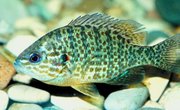
Golden trout are California's official freshwater fish, due in part not only to their color, but also because California is their natural habitat. Golden trout are generally caught with artificial flies, but fly fishing requires a fly rod and expensive tackle. However, you can catch golden trout with bait or lures. There is no single bait or lure that works best in all circumstances, but certain bait offerings can substantially increase your odds of catching these fish. Even with the right equipment, care must be taken to use the proper fishing techniques, and to fish in the right locations.
Lures
Metal spoons are among the more popular lure choices for catching golden trout. Spoons are produced in a variety of shapes, but they all consist of a weighted metal piece and a single treble hook. It is important to remember that golden trout are considerably smaller than rainbow, brook and brown trout. For this reason, use a spoon size of between 1/32 and 1/8 oz. for golden trout. Because of the light weight of these spoons, casting may be problematic, particularly if casting into a breeze. Crimp a lead split shot weight about 2 feet up the fishing line to increase the length of your cast if necessary. Look for spoons with a gold finish for this species.
Bait
Insects and larvae make up the bulk of a golden trout's diet, but they will take other bait types. Crickets, salmon eggs, mealy worms and nightcrawlers have all been used with success. Nightcrawlers should be cut into small pieces to accommodate the size of most golden trout. Thread crickets, mealy worms and nightcrawlers onto a number 10 or number 16 size single hook. A single salmon egg may also be fished with the same hook size, or you can thread three salmon eggs on a size 18 treble hook.
Techniques
Natural presentation is key to successfully catching these notoriously cautious fish. Golden trout, like all trout species, generally face upstream and wait for food to drift toward them. For this reason, position yourself behind the fish and cast upstream when using bait. The trick with this technique is to reel line in as the bait offering drifts downstream, but do it without reeling the bait in faster than the current carries it. Whereas bait should be cast upstream, spoons should be cast downstream and pulled upstream for two reasons. First, spoons attract trout with their shimmy motion, which is difficult to create if the spoon tumbles downstream. Second, spoons are designed to replicate small fish, which do not tumble downstream naturally. Regardless of whether you are casting upstream or downstream, stay as low as reasonably possible to the ground to avoid detection. If the trout detect you, it may be hours before they feed again.
Locations
Golden trout are generally located along the easternmost half of the state and north of San Bernardino County. Fresno and Tulare counties are among the most populated golden trout areas. Unlike other trout species, goldens are usually found only at elevations between 8,500 and 12,000 feet. It is due to the high elevations and moderate summer temperatures that goldens are considerably smaller than other trout species. Look for golden trout in shallow streams.
References
- "Trout Fishing in California: Secrets of the Top Western Anglers"; Ron Kovach; 2005
Writer Bio
John Stevens has been a writer for various websites since 2008. He holds an Associate of Science in administration of justice from Riverside Community College, a Bachelor of Arts in criminal justice from California State University, San Bernardino, and a Juris Doctor from Whittier Law School. Stevens is a lawyer and licensed real-estate broker.



